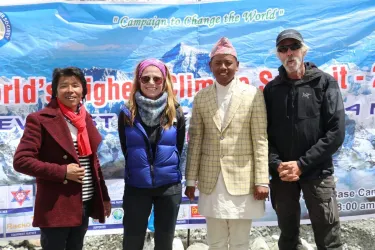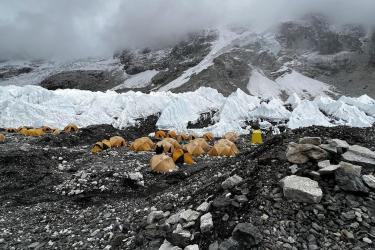CU professor treks to the top of the world to share urgent wildlife and climate message
Banner image: Joanna Lambert of CU Boulder and Joel Berger of CSU pose with signs from their universities at Everest Base Camp. (Credit: Joanna Lambert)
On a sunny day in May at almost 18,000 feet, rumbles echoed through the Himalayan mountains as giant chunks of ice peeled off the Khumbu Glacier and crashed into the rocky valley below.
A couple hundred feet above this rapidly melting ice flow—on which Mount Everest’s historic South Base Camp is situated—Joanna Lambert delivered the Inaugural Everest Address on Wildlife and Climate at the World’s Highest Climate Summit in Nepal to a small group of brave guides, scientists and filmmakers.
Her goal? To all but shout from the mountaintop about how climate change is increasing human and wildlife conflict around the world, harming not only people, but snow leopards in Tibet and Nepal, lions in India, and bears in the American West.
“There is nothing bigger than Everest,” said Lambert, professor of environmental studies and affiliate professor of ecology and evolutionary biology at CU Boulder. “This expedition was part of a very conscious decision to engage in something that I thought would get attention in a much bigger public way than a scientific journal article.”
Lambert was joined by Colorado State University’s Joel Berger, who received his doctorate degree in biology from CU Boulder in 1978. He led a presentation on Nepal’s legacy on biodiversity, focusing on snow leopards and wild yaks, as well as noting the growing loss of glaciers and the consequences of global warming on biodiversity.
The summit, held on May 29, marked both the 69th anniversary of Edmund Hillary and Tenzing Norgay’s historic summit of Mount Everest and the 75th anniversary of U.S.-Nepal diplomatic relations. The expedition was funded by the Nepal Ministry of Forest and Environment, sponsored by the Nepalese Mountaineering Association and organized by the World Record Holders Society.
Lambert and Berger were the only Americans invited to the international event, and Lambert was the only woman on the team of 20. After arriving in Lukla Airport, considered the most dangerous airport in the world, they joined local guides, Nepali scientists and a film crew—but before ascending the mountain, they squeezed in a rare 1.5 hour meeting with the Vice President of Nepal, Nanda Kishor Pun, at the presidential palace in Kathmandu. Pun was keen to discuss how climate change was impacting his country.
By the time the team finished its 134-mile, 12-day trek to Everest’s South Base Camp at 17,598 feet, Lambert had recovered from severe food poisoning, broken her toe in a freak accident and become the team’s main medical expert—as the two doctors on the trip came down with altitude sickness and had to bow out. But there was never a moment when Lambert wanted to leave.
“Until the day I die I think I will always be seeking adventure,” said Lambert. “This is one of the greatest, most epic, extraordinary experiences I've ever had.”
This one-of-a-kind international conference may also be the last time people ever stay at this historic base camp on the world’s highest glacier, as the quickly thinning ice has become too dangerous for the 1,500 mountaineers, tourists and staff who set up camp there each year. Nepal currently plans to move the site down and off the glacier entirely by 2024.

Trekking to base camp
Joanna Lambert poses with Ama Dablam peak in the distance, on the approach to Mount Everest base camp. Ama Dablam provided a consistent view in the eastern sky for several days as the team trekked to the base camp.

Nepalese yaks carry supplies and equipment for guides and travelers who ascend Mount Everest. A single yak can carry up to 220 pounds and navigate over the dangerous trails and snow as high as 20,000 feet.

The peak of Kala Patthar can be seen from the summit setup near Everest base camp.

Ama Dablam peak
At 22,349 feet, the peak of Ama Dablam, "Mother's necklace," neighbors Mount Everest in the eastern Himalayan range. Ama Dablam is sometimes referred as the "Matterhorn of the Himalayas."

Joanna Lambert, professor of environmental studies and affiliate professor of ecology and evolutionary biology at CU Boulder, near Mount Everest base camp.

Joanna Lambert (second from left) and Joel Berger (far right) pose with Nepalese Mountaineering Association’s Purna Bahadur Rai (far left) and Sancha Bahadur Rai (second from right).

Mount Everest South Base Camp
Orange tents dot the exposed landscape of the historic Mount Everest South Base Camp, located at 17,598 feet above sea level, next to the melting ice fragments of Nepal's Khumbu Glacier. Due to the glacier's decline, Nepal plans to move the official camp down and off the glacier entirely by 2024.

The team mounts Kala Patthar, the peak adjacent to Mount Everest, at about 4 a.m. At almost 19,000 feet high, Kala Patthar provides spectacular views of Everest base camp below.

Colorado State University’s Joel Berger (left) and CU Boulder’s Joanna Lambert (right) hold flags from their respective universities in front of a graffitied rock marking the elevation of Everest base camp (17,598 feet).

The team continues their ascent to Everest base camp as the sun rises over the valley of snow and ice. The landscape is so otherworldly, Lambert describes parts of the journey like being on the moon.

Joanna Lambert (center with pink headband) sits with Joel Berger; the film and sound crew; and Nepalese Mountaineering Association’s Sancha Bahadur Rai, president; Tek Bahadur Rai, vice president; Purna Bahadur Rai, secretary; and Buddi Raj Rai, treasurer.


